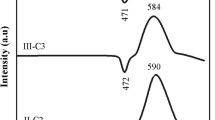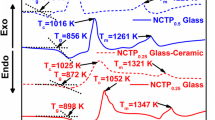Abstract
Ion exchange is a chemical method to increase the mechanical strength on the surface of glass-based materials, in which an exchange between an alkaline ion with smaller radius (from glass) and an alkaline ion with larger radius (from molten salt) is promoted. This creates a superficial compression layer, resulting in mechanical strengthening, compensating the cracks created during processing and use of those glass-based materials. In this context, lithium-based sintered glass-ceramics belonging to the Li2O-ZrO2-SiO2 (LZS) and Li2O-ZrO2-SiO2-Al2O3 (LZSA) systems were summited to ion exchange in a NaNO3 salt bath. The temperatures used in these processes varied from 430°C to 500°C, with immersion times from 15 min to 3 h. After the thermal chemical processes, the LZS glass-ceramics presented a sodium content from 0.20 wt.% to 3.11 wt.%, layer depth up to 2500 µm, and mechanical strength increase up to 19.6%. For the LZSA glass-ceramics, the sodium content varied from 0.23 wt.% to 1.03 wt.% and a layer depth up to 2300 µm was obtained, with a 30.4% mechanical strength decrease. For both glass-ceramics systems, a diffusion coefficient in the order of 10−5 cm2/s and a Weibull modulus increase were demonstrated. For comparison, the results of previous research work, in which ion exchange using a NaNO3 salt paste method, are also related.







Similar content being viewed by others
Data availability
The raw/processed data required to reproduce these findings cannot be shared at this time as the data also forms part of an ongoing study.
References
J. Deubener, M. Allix, M.J. Davis, A. Duran, T. Höche, T. Honma, T. Komatsu, S. Krüger, I. Mitra, R. Müller, S. Nakane, M.J. Pascual, J.W.P. Schmelzer, E.D. Zanotto, S. Zhou, and J. Non-Cryst, J. Non-Cryst. Solids. https://doi.org/10.1016/j.jnoncrysol.2018.01.033 (2018).
Z. Strnad, Glass-Ceramic Materials: Glass Science and Technology (Elsevier, New York, 1986).
G. Partridge and V. Phillips, Glass Technol. 32, 82 (1991)
S.D. Stookey, Res. Manag. https://doi.org/10.1080/00345334.1958.11755484 (1958).
A.P.N. Oliveira, Materiales vitrocerámicos: características, propiedades y aplicaciones industriales. In: A. Duran, Introducción a los esmaltes cerámicos (1. ed., Faenza, Faenza editrice iberica, 2002)
M.O. Prado and E.D. Zanotto, C. R. Chimie. https://doi.org/10.1016/S1631-0748(02)01447-9 (2002).
F.C. Serbena, V.O. Soares, O. Peitl, H. Pinto, R. Muccillo, and E.D. Zanotto, J. Am. Ceram. Soc. https://doi.org/10.1111/j.1551-2916.2010.04220.x (2011).
A.P.N. Oliveira, T. Manfredini, L. Barbieri, C. Leonelli, and G.C. Pellacani, J. Am. Ceram. Soc. https://doi.org/10.1111/j.1151-2916.1998.tb02411.x (1998).
V.K. Marghussian, and A.S.M. Mesgar, Ceram. Int. https://doi.org/10.1016/S0272-8842(99)00072-3 (2000).
B. Yu, K. Liang, and S. Gu, Ceram. Int. https://doi.org/10.1016/S0272-8842(02)00219-5 (2003).
C.A. Harper, Handbook of Ceramics, Glasses and Diamonds (McGraw-Hill, New York, 2001) https://doi.org/10.1036/0071414673.
L. Hallmann, P. Ulmer, and M. Kern, J. Mech. Behav. Biomed. Mat. https://doi.org/10.1016/j.jmbbm.2018.02.032 (2018).
O.V. Savvova, O.V. Babich, G.K. Voronov, and S.O. Ryabinin, Strength Mat. https://doi.org/10.1007/s11223-017-9890-4 (2017).
A. Ananthanarayanan, G.P. Kothiyal, L. Montagne, and B. Revel, J. Sol. Stat. Chem. https://doi.org/10.1016/j.jssc.2009.10.006 (2010).
M. Shekhawat Int. J. Mater. Phys. 1 (2015)
E. Apel, C. van’t Hoen, V. Rheinberger, and W. Höland, J. Am. Ceram. Soc. https://doi.org/10.1016/j.jeurceramsoc.2006.04.103 (2007).
A.P.N. Oliveira, O.E. Alarcon, T. Manfredini, G.C. Pellacani and C. Siligardi Phys. Chem. Glasses. 41 (2000).
J.D. Teixeira, A.P.N. Oliveira, L. Boehs, F.R. Cesconeto, C. Siligardi, and M.A. Pereira, Mat. Sci. Forum. https://doi.org/10.4028/www.scientific.net/MSF.727-728.1028 (2012).
M.T. Souza, G. Peñarrieta-Juanito, B. Henriques, F.S. Silva, A.P.N. Oliveira, and J.C.M. Souza, Materialia. https://doi.org/10.1016/j.mtla.2018.07.020 (2018).
O.R.K. Montedo, F.J. Floriano, J. OliveiraFilho, C.M. Gomes, D. Hotza, and A.P.N. Oliveira, Ceram. Int. https://doi.org/10.1016/j.ceramint.2011.03.047 (2011).
S. Arcaro, T.B. Wermuth, R.Y.S. Zampiva, J. Venturini, C.S. ten Caten, C.P. Bergmann, A.K. Alves, and A.P.N. Oliveira, J. Euro. Ceram. Soc. https://doi.org/10.1016/j.jeurceramsoc.2018.09.033 (2019).
I.E.F. Pozzobom, G.G. Moraes, R. Balzer, L.F.D. Probst, E.S. Trichês, and A.P.N. Oliveira, Chem. Eng. Trans. https://doi.org/10.3303/CET1543299 (2015).
A.H.B. Teixeira, H.H. Venturelli, O.R.K. Montedo, and A.P.N. Oliveira, Mater. Sci. Eng. A. https://doi.org/10.1016/j.msea.2019.02.055 (2019).
I.W. Donald J. Mater. Sci 24, 4177 (1989).
W.F. Hosford, Mechanical Behavior of Materials, 2nd edn. (Cambridge University Press, Cambridge, 2010).
J.E. Shelby, Introduction to Glass Science and Technology, 2nd edn. (Royal Society of Chemistry, London, 2005).
W.D. Callister, Materials Science and Engineering: An Introduction, 8th edn. (Wiley, New York, 2012).
D.R. Askeland, Ciencia y ingeniaría de los materiales, 3rd edn. (International Thomson Publishing Company, London, 1998).
M.E. Nordberg, E.L. Mochel, H.M. Garfinkel, and J.S. Olcott, J. Am. Ceram. Soc. https://doi.org/10.1111/j.1151-2916.1964.tb14399.x (1964).
P. Gimenez, and S. Fereres, Energy Procedia. https://doi.org/10.1016/j.egypro.2015.03.075 (2015).
R. Gy, Mater. Sci. Eng. B. https://doi.org/10.1016/j.mseb.2007.11.029 (2008).
Z. Shan, J. Liu, M. Liu, F. Shi, C. Wu, C. Wang, and T. Liu, Ceram. Int. https://doi.org/10.1016/j.ceramint.2018.04.037 (2018).
A.K. Varshneya, Int. J. Appl. Glass Sci. https://doi.org/10.1007/BF00544488 (2010).
S. Karlsson and B. Jonson Glass Technol. – Eur. J. Glass Sci. Technol. A. 51, 41 (2010).
J.M.F. Navarro, El Vidrio, 2nd edn. (Consejo Superior de Investigaciones Científicas, Madrid, 1991).
A.K. Varshneya, Fundamentals of Inorganic Glasses (Academic Press, San Diego, 1993).
D.E. Day J. Non-Cryst. Solids. 21, 343 (1976)
G.H. Beall, M. Comte, M.J. Dejneka, P. Marques, P. Pradeau, and C. Smith, Front. Mater. https://doi.org/10.3389/fmats.2016.00041 (2016).
V.M. Sglavo, A. Prezzi, M. Alessandrini, and J. Non-Cryst, J. Non-Cryst. Solids. https://doi.org/10.1016/j.jnoncrysol.2004.07.025 (2004).
L.B. Teixeira, E.G. Moraes, A.P.N. Oliveira, Bol. Soc. Esp. Ceram. Vidr. (2021, in press) https://doi.org/10.1016/j.bsecv.2021.06.006.
J. Crank, The Mathematics of Diffusion, 2nd edn. (Oxford University Press, Oxford, 1975).
ASTM—Annual Book of ASTM standards: C158-2017, Standard test methods for strength of glass by flexure (determination of modulus of rupture), 2017.
T.O. Yusuf, M. Ismail, J. Usman, and A.H. Noruzman, Adv. Civ. Eng. https://doi.org/10.1155/2014/658067 (2014).
B. Bergman, J. Mat. Sci. Letters. 3, 689 (1984)
G. Hu, C.M. Smith, Z. Tang and S.A. Tietje (2020) Glass and glass ceramics including a metal oxide concentration gradient (U.S. Patent No. 10,730,791 B2).
X.C. Li, D. Li, M. Meng, R. Wei, L. He, and S.F. Zhang, Ceram. Int. https://doi.org/10.1016/j.ceramint.2019.07.300 (2019).
X.C. Li, M. Meng, D. Li, R. Wei, L. He, and S.F. Zhang, J. Am. Ceram. Soc. https://doi.org/10.1016/j.jeurceramsoc.2020.05.075 (2020).
E.M. Aaldenberg, P.J. Lezzi, J.H. Seaman, T.A. Blanchet, and M. Tomozawa, J. Am. Ceram. Soc. https://doi.org/10.1111/jace.14294 (2016).
R.C. Andrews, J.M. Hall, P. Oram, R.V. Roussev, V.M. Scheneider and L. Ukrainezyk (2019) Lithium containing glass or glass ceramic article with modified K2O profile near the glass surface (U.S. Patent No. 2019/0389746 A1).
M. Laczka, K. Laczka, K. Cholewa-Kowalska, A.B. Kounga, and C. Appert, J. Am. Ceram. Soc. https://doi.org/10.1111/jace.12780 (2014).
ICSD—Inorganic Crystal Structure Database. http://www.icsd-fiz-karlsruhe-de_proxy.dotlib.com.br/search/basic.xhtml. Accessed February 2020.
P.J. Steiner, J.R. Kelly and A.A. Giuseppetti, Int. J. Prosthodont 10 (1997)
H. Shermer, J. Res. Nat. Bureau Standards. https://doi.org/10.6028/JRES.057.012 (1956).
F.X. Liang, C.L. Sun, H.Y. Yang, E.Z. Li, and S.R. Zhang, J. Mater. Sci. https://doi.org/10.1007/s10854-017-7426-0 (2017).
J.M. Marr, and F.P. Glasser, Min. Mag. https://doi.org/10.1180/minmag.1979.043.325.19 (1979).
Acknowledgements
This study was financed in part by the Coordenação de Aperfeiçoamento de Pessoal de Nível Superior (CAPES) – Brazil, Grant No. 88881.310728/2018-01.The authors are grateful for the support also provided by Conselho Nacional de Desenvolvimento Científico e Tecnológico (CNPq) – Brazil, Grant Numbers: 444249/2014-1 and 407032/2013-4. A special thanks to the technical staff of the Mechanical Forming Laboratory (Labconf), Ceramic and Composite Materials Research Laboratory (Cermat), Materials Laboratory (LabMat), from the Federal University of Santa Catarina (UFSC).
Author information
Authors and Affiliations
Contributions
L.B. Teixeira: Conceptualization, Data curation, Formal analysis, Investigation, Methodology, Writing—original draft, Writing—editing. E.G. Moraes: Data curation, Formal analysis, Investigation, Methodology, Writing—review. A.P.N. Oliveira: Conceptualization, Funding acquisition, Writing—review, Project administration, Supervision.
Corresponding author
Additional information
Publisher's Note
Springer Nature remains neutral with regard to jurisdictional claims in published maps and institutional affiliations.
Rights and permissions
About this article
Cite this article
Teixeira, L.B., de Moraes, E.G. & de Oliveira, A.P.N. Chemical Strengthening of Li2O-ZrO2-SiO2 (LZS) and Li2O-ZrO2-SiO2-Al2O3 (LZSA) Sintered Glass-Ceramics. JOM 74, 4188–4201 (2022). https://doi.org/10.1007/s11837-022-05340-x
Received:
Accepted:
Published:
Issue Date:
DOI: https://doi.org/10.1007/s11837-022-05340-x




